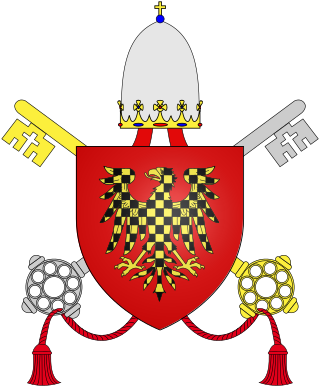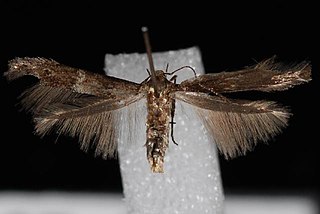
Pope Alexander IV was head of the Catholic Church and ruler of the Papal States from 12 December 1254 to his death in 1261.

Sorhagenia is a genus of moths in the family Cosmopterigidae. The name honours Ludwig Friedrich Sorhagen.
The Taurus ground squirrel is a species of rodent in the family Sciuridae. It is endemic to the Taurus Mountains of Turkey. It was first identified as a distinct species to the Asia Minor ground squirrel in 2007.

Sorhagenia janiszewskae is a moth in the family Cosmopterigidae. It is found from Great Britain to Russia and from Fennoscandia to France, Switzerland, Austria, Croatia, Hungary and Romania. It has also been reported from Portugal, the Caucasus and western Transcaucasia.

Sorhagenia lophyrella is a moth in the family Cosmopterigidae. It is found in most of Europe, Asia Minor and the Caucasus.
Sorhagenia reconditella is a moth in the family Cosmopterigidae. It is found in Greece and on Cyprus.

Sorhagenia rhamniella is a moth in the family Cosmopterigidae. It is found in most of Europe, except the Balkan Peninsula.
The Chrysopeleiinae are a subfamily of the Cosmopterigidae, although some authors treat it as a full family, the Chrysopeleiidae.
Sorhagenia fibigeri is a moth in the family Cosmopterigidae. It is found in Asia Minor.
Sorhagenia baucidis is a moth in the family Cosmopterigidae. It was described by Ronald W. Hodges in 1969. It is found in North America, where it has been recorded from Illinois and Saskatchewan.
Sorhagenia cracens is a moth in the family Cosmopterigidae. It was described by Ronald W. Hodges in 1978. It is found in North America, where it has been recorded from Idaho.
Sorhagenia daedala is a moth in the family Cosmopterigidae. It was described by Ronald W. Hodges in 1964. It is found in North America, where it has been recorded from California.
Sorhagenia dahurica is a moth in the family Cosmopterigidae. It was described by Sinev in 1986. It is found in Russia.
Sorhagenia maurella is a moth in the family Cosmopterigidae. It was described by Sinev in 1993. It is found in Russia.

Sorhagenia nimbosus, the midrib gall moth, is a moth in the family Cosmopterigidae. It was described by Annette Frances Braun in 1915. It is found in North America, where it has been recorded from British Columbia, Washington and California.
Sorhagenia pexa is a moth in the family Cosmopterigidae. It was described by Ronald W. Hodges in 1969. It is found in North America, where it has been recorded from Texas, Arkansas and Illinois.
Sorhagenia vicariella is a moth in the family Cosmopterigidae. It was described by Sinev in 1993. It is found in Russia.
Sorhagenia riedli is a moth in the family Cosmopterigidae. It was described by Sinev in 1986. It is found in Russia.
Sorhagenia griseella is a moth in the family Cosmopterigidae. It was described by Sinev in 1993. It is found in Russia.



